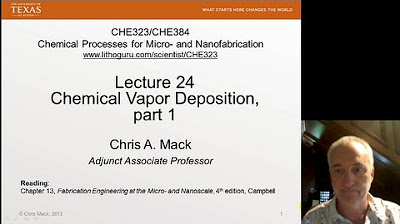Rate Determining Step and Reaction Mechanisms 1
Summary
TLDRThe video explains the concept of the rate-determining step (RDS) in chemical reactions, which is the slowest step in a reaction mechanism and governs the overall reaction rate. The presenter draws analogies, such as a chain being only as strong as its weakest link, to help explain the concept. The video also discusses how rate equations are linked to the RDS, how to determine reaction mechanisms, and demonstrates with examples how the rate-determining step influences chemical reactions by analyzing the number of reactants involved.
Takeaways
- 🔄 Chemical reactions usually occur in multiple steps, referred to as reaction mechanisms.
- 🐢 The rate-determining step (RDS) is the slowest step in a reaction mechanism, and it governs the overall rate of the reaction.
- 🔗 A chain is only as strong as its weakest link, and similarly, a reaction’s speed is determined by its slowest step.
- 🏃♂️ In a relay race analogy, the slowest runner determines the team’s overall performance, just like the RDS in reactions.
- 🧪 Rate equations help understand the speed of a reaction and are linked to the rate-determining step.
- ⚖️ The order of a substance in the rate equation reflects the number of molecules involved in the RDS (e.g., if order is 2, two molecules are involved).
- 🔍 The example reaction involves NO2 and shows how the rate equation (second order in NO2) determines that two NO2 molecules participate in the RDS.
- ➗ Reaction mechanisms can consist of multiple steps, and the intermediate steps might not appear in the overall equation but must cancel out appropriately.
- 🧩 The mechanism of a reaction must satisfy two conditions: the RDS must align with the rate equation, and the steps must sum to give the overall reaction equation.
- 🔄 There can be more than one valid mechanism for the same reaction, as long as it meets the necessary conditions.
Q & A
What is the rate-determining step (RDS) in a reaction mechanism?
-The rate-determining step (RDS) is the slowest step in a reaction mechanism, and it governs the overall rate of the chemical reaction.
How does the rate-determining step relate to the overall reaction rate?
-The overall reaction rate is determined by the slowest step in the reaction mechanism, which is the rate-determining step.
What is the analogy used to explain the concept of the rate-determining step?
-Two analogies are used: (1) A chain is only as strong as its weakest link, and (2) a relay team’s performance is governed by its slowest member.
How does the rate equation relate to the rate-determining step?
-The rate equation provides information about the reactants involved in the rate-determining step. The reactants in the rate equation must be part of the RDS.
What does the order of a reactant in a rate equation tell us about the rate-determining step?
-The order of a reactant indicates how many molecules of that reactant are involved in the rate-determining step. For example, if a reactant has an order of 2, two molecules of it are involved in the RDS.
What can we infer from a rate equation that only involves one reactant, NO₂, in the reaction NO₂ + CO → NO + CO₂?
-Since the rate equation only involves NO₂, the rate-determining step must involve two molecules of NO₂. CO does not participate in the RDS, indicating that another step must involve CO.
How do the steps in a reaction mechanism combine to form the overall equation?
-The steps of a reaction mechanism must add up to form the overall (net) reaction equation. This is similar to solving simultaneous equations where intermediates cancel out, and the sum gives the overall reaction.
Why is it important to understand the link between the rate-determining step and the overall equation?
-Understanding this link helps us determine the correct reaction mechanism. The RDS must be consistent with the rate equation, and the sum of the steps must match the overall reaction.
What is the role of guesswork in proposing reaction mechanisms?
-There is some guesswork involved in proposing reaction mechanisms, especially when determining intermediates and products for individual steps. Multiple mechanisms can be valid as long as they satisfy the two conditions: consistency with the rate equation and summing to the overall equation.
Can there be more than one valid mechanism for a given reaction?
-Yes, there can be more than one valid mechanism for a reaction, as long as both mechanisms satisfy the conditions that the RDS is consistent with the rate equation and the steps combine to give the overall reaction equation.
Outlines

此内容仅限付费用户访问。 请升级后访问。
立即升级Mindmap

此内容仅限付费用户访问。 请升级后访问。
立即升级Keywords

此内容仅限付费用户访问。 请升级后访问。
立即升级Highlights

此内容仅限付费用户访问。 请升级后访问。
立即升级Transcripts

此内容仅限付费用户访问。 请升级后访问。
立即升级浏览更多相关视频
5.0 / 5 (0 votes)






